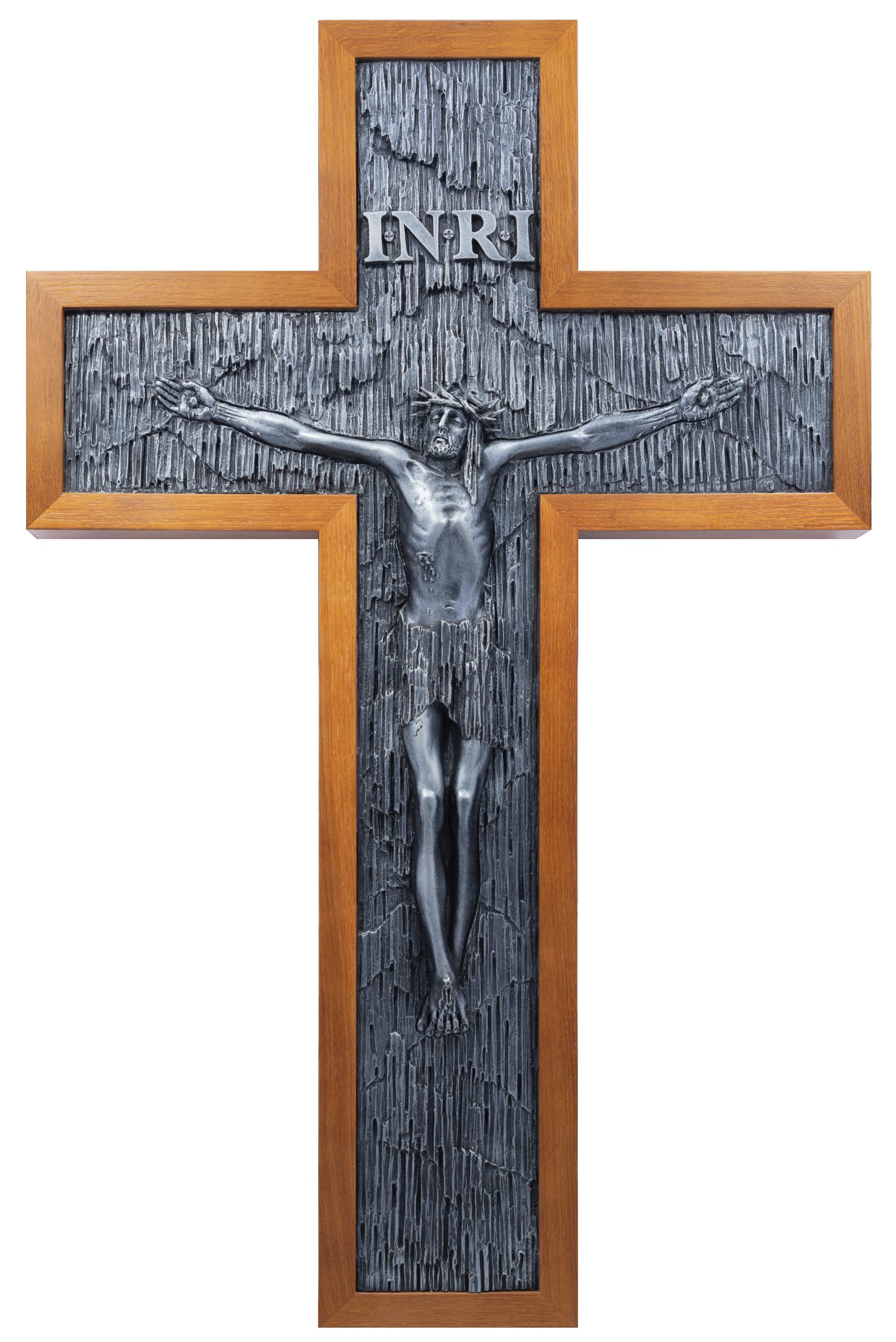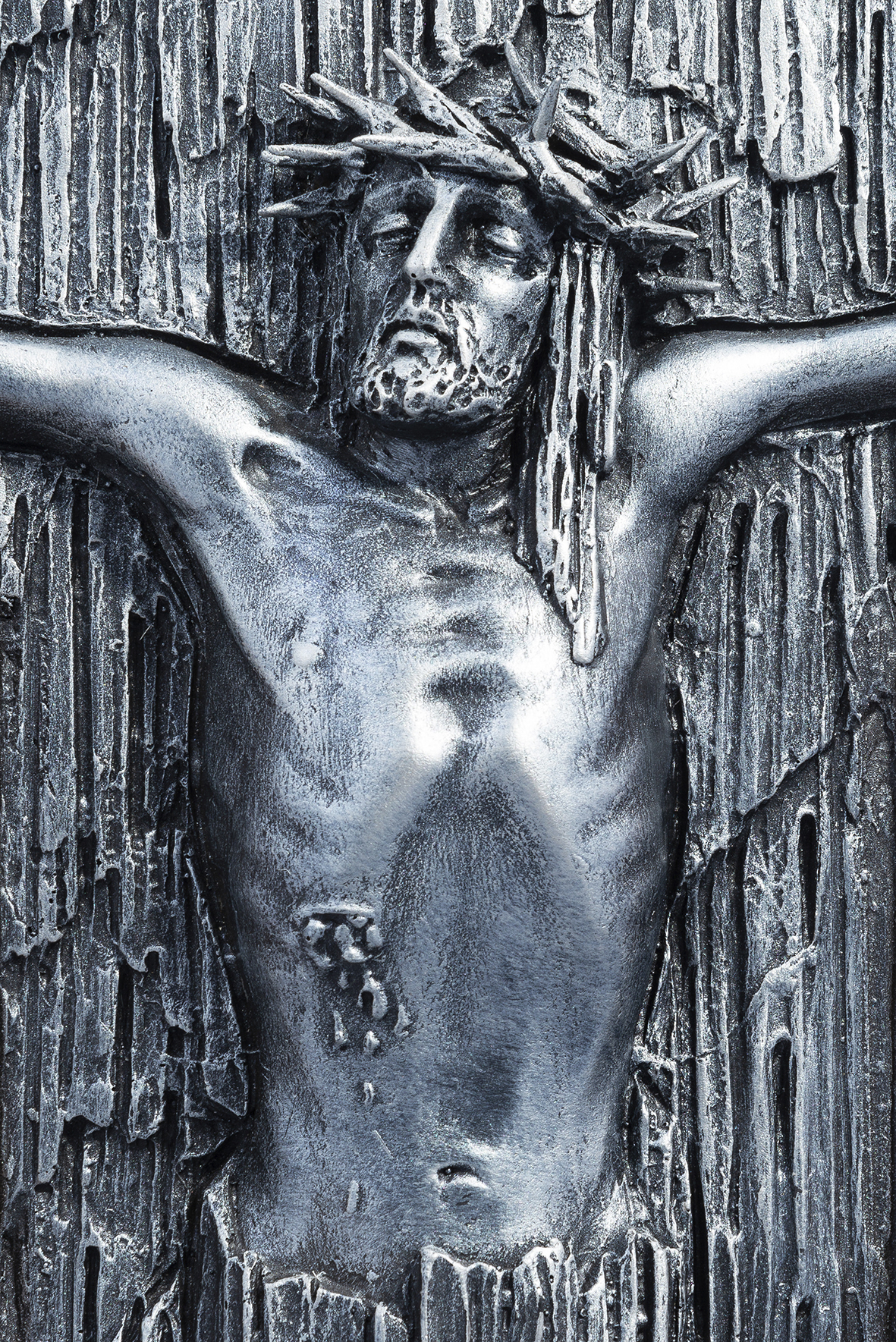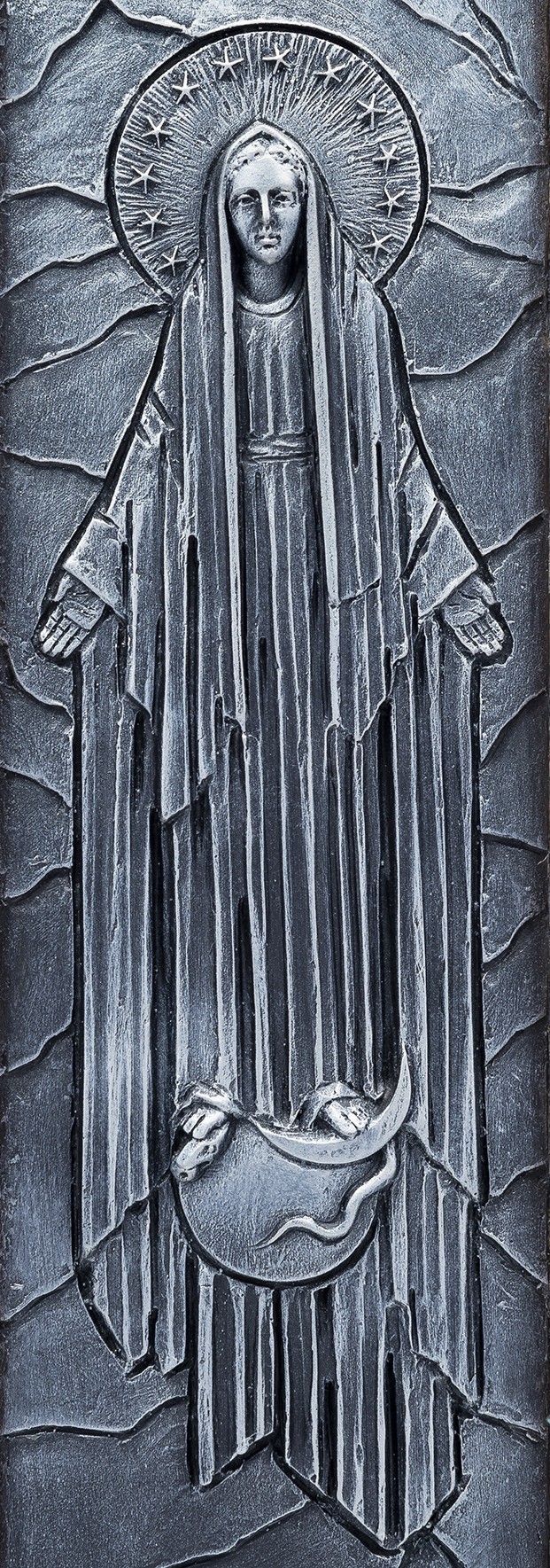The Symbolism of the “Perpetual Cross” of the Marian Fathers and Its Meaning
The Cross, associated with Christianity, is a sign of the special love of God, which proclaims the victory of Jesus Christ, God-Man, over death. The Crucified One shows love that transforms the world, freedom that does not choose sin and is not scared of death. The Cross poses a continuous challenge to the world, even if the latter considers it a stumbling block and foolishness (cf. 1 Corinthians 1:23).
It can be assumed that specific events in the life of our Founder, Stanislaus of Jesus and Mary Papczyński, became the locus theologicus of his reflections on suffering and the Cross of Christ. We may find them, among others, in the considerations Orator crucifixus and Christus patiens. The mystery of the Crucified Christ is also present in Oblatio of December 11, 1670, which was both religious vows of Fr. Stanislaus and a certain culmination of his life. Fr. Stanislaus begins his Oblatio “In the Name of Our Lord Jesus Christ Crucified.” Following the example of their Fr. Founder, Marians accept the evangelical way of life and sanctification by willingly and consciously taking the religious vows of chastity, poverty, and obedience, and receive the Cross of Christ as a sign of their perpetual consecration, together with the promise of eternal life.
The “Perpetual Cross,” as we call it, designed by Mr. Witold Czopowik, has unique symbolism connected with the way of life specific to Marian charism. The essence of the charism of our religious congregation includes the mystery of the Immaculate Conception of the Most Blessed Virgin Mary which has been, from the very beginning, a particular sign, strength, and joy of the Marian vocation, as well as the source of its mission (cf. Constitutions of the Marian Fathers, §2).
What is the symbolism of the Perpetual Cross and its meaning?
The unity of the Congregation. The committee preparing the program of the 350th Jubilee of the origin of the Congregation of Marian Fathers (2019-2023) suggested that making the perpetual profession should be accompanied by acceptance of the cross, which ought to be uniform. In practice, confrères did receive crosses as signs of the taken religious vows, but they were as different as particular jurisdictions or predilections of confréres and superiors. Alongside traditional images of Christ crucified, one could find crosses associated with other religious traditions, e.g. the St. Benedict cross. The members of the Jubilee Committee concluded that it is worth including charismatic and specifically Marian elements in the design of the Perpetual Cross. It was decided that the obverse should present the unchangeable image of Christ crucified, whereas the reverse symbolism would refer to the mystery of the Immaculate Conception of the Most Blessed Virgin Mary. Hence on the aforementioned reverse we can see Immaculate Mary standing at the foot of the Cross; the hand of God the Creator in the upper part of the vertical beam of the Cross; and the Holy Spirit in the sign of a dove at the intersection of the beams – the horizontal and the vertical ones. It is worth noting the background, which is different – on the obverse we can see the vertical lines, whereas on the reverse descending planes arranged horizontally.
The meaning of the obverse and the reverse. In the foreground, there is an image of the Son of God, Jesus Christ, nailed to the wood of the Cross and dying on it. Also visible is a traditional titulus, i.e. the plaque with the inscription abbreviated to INRI (from Latin: Iesus Nazarenus Rex Iudeorum). This is how Pontius Pilate explained the reason why Christ was sentenced to death by crucifixion in accordance with the Roman law. The tradition is consistent in this respect with the description from St. John’s Gospel: “Pilate had a notice prepared and fastened to the cross… and the sign was written in Aramaic, Latin and Greek” (cf. John 19:19-22).
Let’s examine two elements in closer detail. First, the head of the crucified Christ is directed upwards, to God the Father. Such a depiction refers to the images described by the term semitivo, composed of the words: semi and vivus, which can be translated from Latin as “half dead,” “more dead than alive,” “at the end of life,” and “dying.” In his considerations in Orator crucifixus, Fr. Founder evokes the words of Christ:
Father, forgive them, for they do not know what they are doing (Luke 23:34).
I tell you the truth, today you will be with me in paradise (Luke 23:43).
“Dear woman, here is your son,” and to the disciple, “Here is your mother” (John 19:26-27).
My God, my God, why have you forsaken me? (Matthew 27:46)
I am thirsty (John 19:28).
It is finished (John 19:30).
Father, into your hands I commit my spirit (Luke 23:46).
Also, in Christus patients we find reflections on “the Glorious Cross” (Mark 15:25) and “the death of Death” (Mark 15:37). By evoking those words, both of Fr. Founder and of the Gospel message, we confirm the unchangeable faith of the Church in the real death of Christ on the Cross, His burial, and His glorious Resurrection. God in Christ has loved man and accompanies him till the end. While focusing our attention on Christ dying on the Cross, we realize that in this moment of entering death Christ is united in a special way with every man facing death, i.e. passing into eternity. Thus, the Perpetual Cross recalls one of the elements of the charismatic mission of the Congregation, which is assistance to the dying and the deceased suffering in Purgatory (cf. Constitutions of the Marian Fathers, §8).
The other element worthy of our attention is the background. It is composed of numerous densely engraved vertical lines. At the back, as if behind those lines, a set of horizontal contours break through, which we can clearly observe on the reverse. Let’s consider these for a moment. We notice on it a peaceful, free of any disturbance, set of descending horizontal planes, symbolizing goodness and love, with which God creates the world, endowing it with its proper harmony and placing in it man, made in His image and likeness (cf. Genesis 1:1-31). Here, we must not overlook the hand of God the Father, placed on the apsidal mosaics of ancient churches, which means that God has never showed His Face to anybody, but He reveals Himself in His actions and most fully in His Son, Jesus Christ. The hand, shown in the upper part of the vertical arm of our Perpetual Cross, refers to the fresco on the ceiling of the Sistine Chapel, whose creator is Michelangelo Buonarotti. The fresco, one of the most important masterpieces of Renaissance art, depicts the Creation of Adam. Adam, who seems to be waking up, extends his finger in the direction of his Maker. God gives an impression of an extremely dynamic figure: He floats in the air, full of energy and engagement, surrounded by flying cherubs, extending His arm towards Adam, as if making a bridge between the divine and the human. The figure of God from the Sistine Chapel seems to be on the verge of breaking through the ceiling and descending powerfully into the Chapel itself, among the people. God is engaged in His creation; He gives it the breath of life, which is the Holy Spirit.
Especially favored in the Creation is the Immaculate Virgin Mary, foreseen by God for ages to become the Temple of the Holy Spirit, the Dwelling of the Son of God and the eternal Word of God, the Ark of Covenant between God and men. She is foretold in the book of Genesis (cf. Genesis 3:1-15) in connection with the fall of the first humans who were deceived by Satan’s lies, symbolically presented by the snake entwinning the earth under her feet, over which she towers and tramples him; her offspring is destined to crush his head. Obviously, satanic temptations brought about disharmony in the creation, confused its original meaning and beauty, and made it difficult to recognize in it goodness or even omnipotence of its Creator.
Therefore, coming back to the obverse, full of dynamism of ascending and descending horizontal lines that form the rough surface of the background (and blur somewhat the original meaning and beauty of the Creation), one cannot help but notice the image of Christ, who came to the wounded and anguished world in order to reveal the Father (cf. John 1:18; 14:6-9; 1 Timothy 2:5), and through Himself reconcile all things to Him (cf. Colossians 1:15-20).
Besides the aforementioned meanings, we need to emphasize that the Paschal events of the glorious Passion, Death, and Resurrection of Christ the Lord undoubtedly bridge the obverse and the reverse of the Perpetual Cross and allow us to see the person of the Immaculate Virgin as the most perfect masterpiece of the Holy Trinity. We see the truth of her Immaculate Conception engraved on our Perpetual Cross. We derive it from the experience of our Fr. Founder, in accordance with the Tradition and Magisterium of the Church, and we proclaim it to the world. In 1670, while making his Oblatio, Fr. Stanislaus vowed:
I confess that I believe everything which the holy Roman Church believes and everything that she will henceforth teach to be believed. Particularly, I confess in truth that Mary, the Most Holy Mother of God, was conceived without the stain of original sin, and I promise that I will promote and defend her honor even at the cost of my life.
This seed of faith in the Immaculate Conception of the Mother of God had been growing in the tradition of the Church and was revealed in its full glory when Blessed Pope Pius IX issued the bull Ineffabilis Deus on December 8, 1854, thus proclaiming the dogma of her Immaculate Conception as follows:
We declare, pronounce, and define that the doctrine which holds that the most Blessed Virgin Mary, in the first instance of her conception, by a singular grace and privilege granted by Almighty God, in view of the merits of Jesus Christ, the Savior of the human race, was preserved free from all stain of original sin, is a doctrine revealed by God and therefore to be believed firmly and constantly by all the faithful.
This pronouncement was made ex cathedra, which meant exercising the highest degree of papal authority in teaching Christian truths in matters of faith and morals. We express this truth of faith in our Constitutions:
In the following of Christ, the Immaculate Virgin Mary assists us and shows us the way. From her conception, free from sin and full of grace and filled with the gratuitous love of the Holy Spirit, she is the fruit of the paschal victory of Christ and the first partaker of the redemption. She reveals the creative and salvific love of the Most Holy Trinity; she is the image of the new man capable of a relationship with God and others, the beginning of the new People of God and the seed of a new humanity. Contemplating the Immaculate Conception of Mary together with the whole Church, let the confreres come to know this mystery, love, profess, celebrate, and proclaim it. Let them draw inspiration from it for their spiritual life, communal life, and apostolate. By this mystery above all, Mary urges the confreres to trust in the unlimited fruitfulness of the work of redemption, to avoid all sin, to love purity of heart, to imbue life fully with divine grace and charity, and to so build up the Church in unity “that she be holy and without blemish” (Eph 5:27) (Constitutions of the Marian Fathers, 8).
Mission: The witness of holiness becomes attractive for the contemporary world when it identifies with the crucified and risen Christ. It is undoubtedly a response to attempts at negating the omnipotence and goodness of God the Creator as well as to the temptation of defining the Creation anew, which devastates the human nature that reminds us that we come from God.
The mystery of the Immaculate Conception of the Most Blessed Virgin Mary as the greatest masterpiece of the Holy Trinity shows the potential of man according to God’s plan. It is a testimony to the omnipotence, love, goodness, and beauty of God. It shows the primacy of the work of God and his grace. By revering the Immaculate Conception of the Most Blessed Virgin Mary, Marians restore the supernatural life to its proper place and proclaim the victory of Christ over Satan, sin and death, thereby becoming partakers of the salvific work of God for sanctification of themselves and others.
Meaning of the whole: The Holy Spirit imparted to Fr. Founder the gift of unique inner intuition in perceiving the life and mission of Jesus Christ (cf. Fundatio Domus Recollectionis, 6) This original spiritual conviction inspired Fr. Stanislaus to gain an even greater insight into the chosen element of the mystery of Christ. In fact, our acceptance of the Perpetual Cross is our original way of acknowledging that the most important dimension of the charism discerned by Fr. Founder is its Christocentric character. The mission, to which the Holy Spirit called Fr. Founder, does not primarily consist in imitation of a certain virtue, like poverty, obedience, charity, or in fulfilling specific tasks like educating the ignorant and the young, taking care of the poor, or even of the dying and the souls in Purgatory. They are indeed included in his vocation, but the first and fundamental element of the vocation of Fr. Founder is the call to imitate Christ and to fully conform to Him, especially to Him crucified. Inspired by God, Fr. Stanislaus venerated the mystery the Immaculate Conception of the Most Blessed Virgin Mary and, through it, united himself with Christ. Inheriting this element of Fr. Founder’s spirituality is the sine qua non condition for formation of the strong identity both of the whole Congregation and its individual members. This specific form of uniting with Christ becomes a source and spiritual strength for the growth of the work which is the Congregation.
Tomasz Nowaczek, MIC








